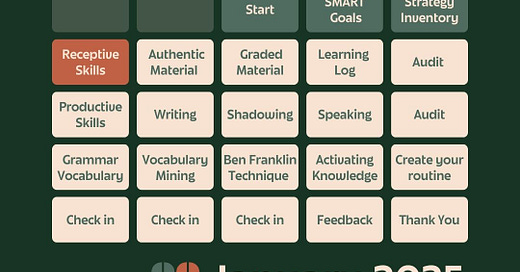For the next five weeks, I’ll be sharing quick posts to help you build a sustainable and joyful language learning practice. This series, Fresh Foundations, is all about actionable steps you can take in just 15-30 minutes a day to create a language learning routine that works for you.
If that sounds like something you’re ready for, let’s get into the activity for Day 4!
Day 4: Receptive Skills
Today’s post is a little different. We’re exploring some important theory that will help you build a stronger foundation for your receptive skills: listening and reading. This theory is the basis for the practical activities that are coming later in the week.
Receptive skills are critical for understanding and using a language naturally, and they rely on a powerful concept called comprehensible input.
What Is Comprehensible Input?
The idea of comprehensible input comes from linguist Stephen Krashen’s Second Language Acquisition theory. He describes it as input that is just slightly beyond your current level, or “input +1” (i+1).
Think of “i” as your current ability and “+1” as that little challenge which pushes you to grow. For example:
If you’re comfortable reading basic articles, “i+1” might be a slightly longer article with a few unfamiliar words.
If you’re used to slow, clear speech, “i+1” might be a podcast with natural pacing but familiar topics.
Comprehensible input allows you to understand the general meaning (thanks to the context and what you already know) while picking up new vocabulary and structures naturally.
Why Comprehensible Input Matters
Comprehensible input can feed your language learning journey. Here’s why it’s so effective:
Natural Vocabulary Growth: Instead of memorizing lists of words, you encounter them in real-life contexts. This helps you expand your range (one of our objectives at an intermediate level!).
Understanding Patterns: You start to see how words and grammar fit together without consciously studying the rules.
Building Confidence: As you understand more, you’ll feel a sense of progress, which motivates you to keep going.
The key is consistency. Regular exposure to i+1 material reinforces what you know and introduces just enough new information to keep you improving.
Making Input Comprehensible
If input feels too difficult, it won’t help. Over the next week, we’ll explore strategies for finding and adapting materials to your level, but here’s a preview:
Use Tools: Subtitles, transcripts, and dictionaries can make challenging material more accessible.
Start Simple: Graded readers and beginner-friendly podcasts are designed to give you that perfect i+1 balance.
Repeat and Chunk: Revisit the same material multiple times, focusing on understanding phrases or sentences rather than individual words.
The next concept that’s important to keep in mind when it comes to receptive skills practice is active vs. passive exposure.
Active vs. Passive Exposure
To grow your receptive skills, it’s important to balance active and passive exposure.
Active Exposure:
This is focused, intentional practice where you aim to engage deeply with the material. For example:
While watching a video, you pause to check unfamiliar words.
Take notes while reading an article or summarize key points.
Practice “shadowing” by repeating after a speaker.
Active exposure is efficient, but it also requires more effort and energy. If you force yourself to focus only on active exposure, you’re likely to burn out and give up on language learning. (I’ve seen this happen many, many times.) That’s why we need to balance it with passive exposure.
Passive Exposure:
This happens when you’re not actively focusing on the language but still surrounded by it. Examples include:
Listening to a podcast in the background.
Watching a TV show casually, without pausing for details.
Reading for pleasure.
Hearing announcements or conversations in your target language during a trip.
While passive exposure isn’t as intense, it’s still valuable for improving your familiarity with the language’s rhythm, sounds, and structure. A mix of both types of exposure creates a well-rounded approach to receptive skills and keeps you motivated to stick with your routine.
Overcoming Frustration
Speaking of motivation, it’s completely normal to feel frustrated when you’re at an intermediate level. You’ve already put in a lot of effort, and sometimes it can feel like progress has stalled. You’re not alone. This is a common experience, and there are ways to manage it:
1. Focus on the Gist: You don’t need to understand every word to get the main idea. Aim for the overall meaning instead of perfection.
2. Set Realistic Expectations: Remember, even native speakers don’t know every word in their language. Progress comes with time.
3. Chunk Your Practice: Instead of long, exhausting sessions, try 10-15 minutes of focused input at a time.
4. Celebrate Small Wins: Notice the words or phrases you do understand. Progress is progress.
Remember that every day in your language learning journey will be different. Some days, everything might click, and understanding feels effortless. Other days, you may wonder if you’ve made any progress at all, which is completely normal! This ebb and flow is part of the process, and embracing it early on will help you stay motivated.
When you have a challenging language day, don’t let it discourage you. Shake it off and start with something simpler the next day. The goal is to build habits that last a lifetime, so keeping the process enjoyable and manageable is key.
What’s Next
Over the next week, we’ll get into:
How to adapt authentic materials so they’re comprehensible.
Finding and using graded materials at your level.
Using active engagement to track your progress in a language log.
For today, take some time to reflect on your current listening and reading habits. Are you using i+1 material? Are there areas where you could challenge yourself more, or tools you could add to make input easier to understand?
This foundational work will set you up for success as we continue to refine your language learning strategies.
Happy Language Learning!
Christina





